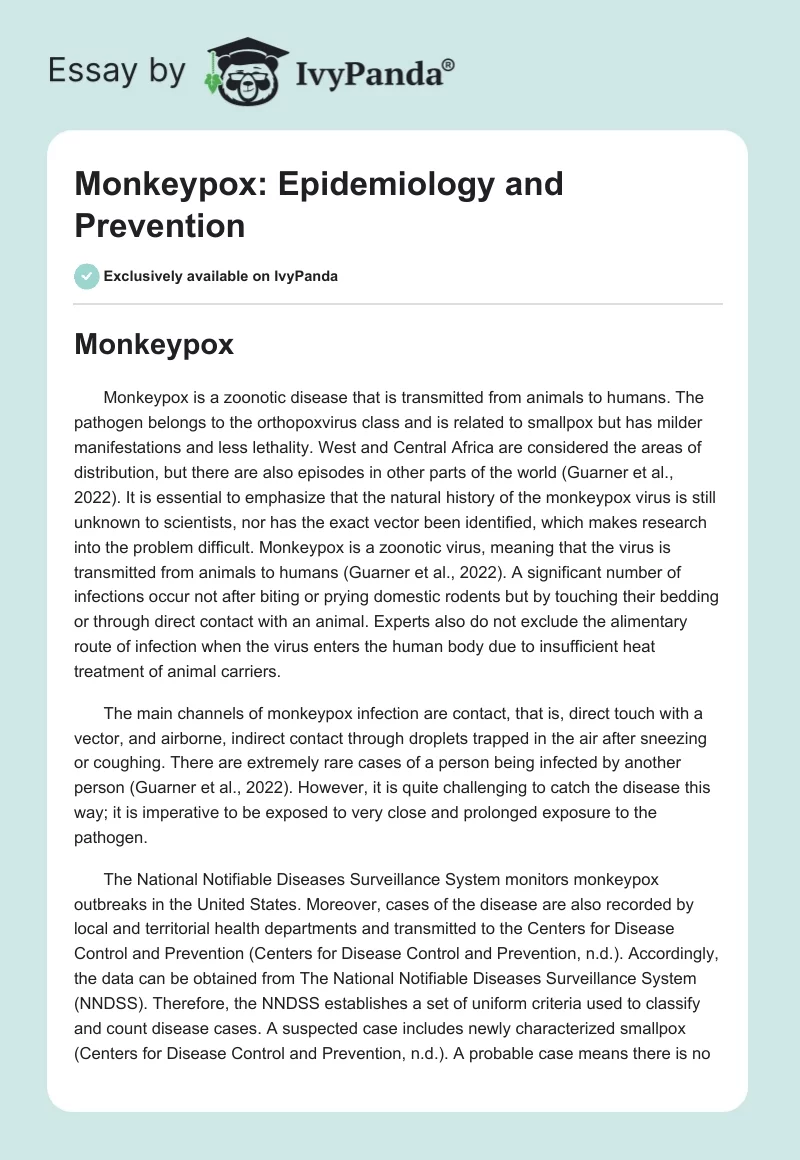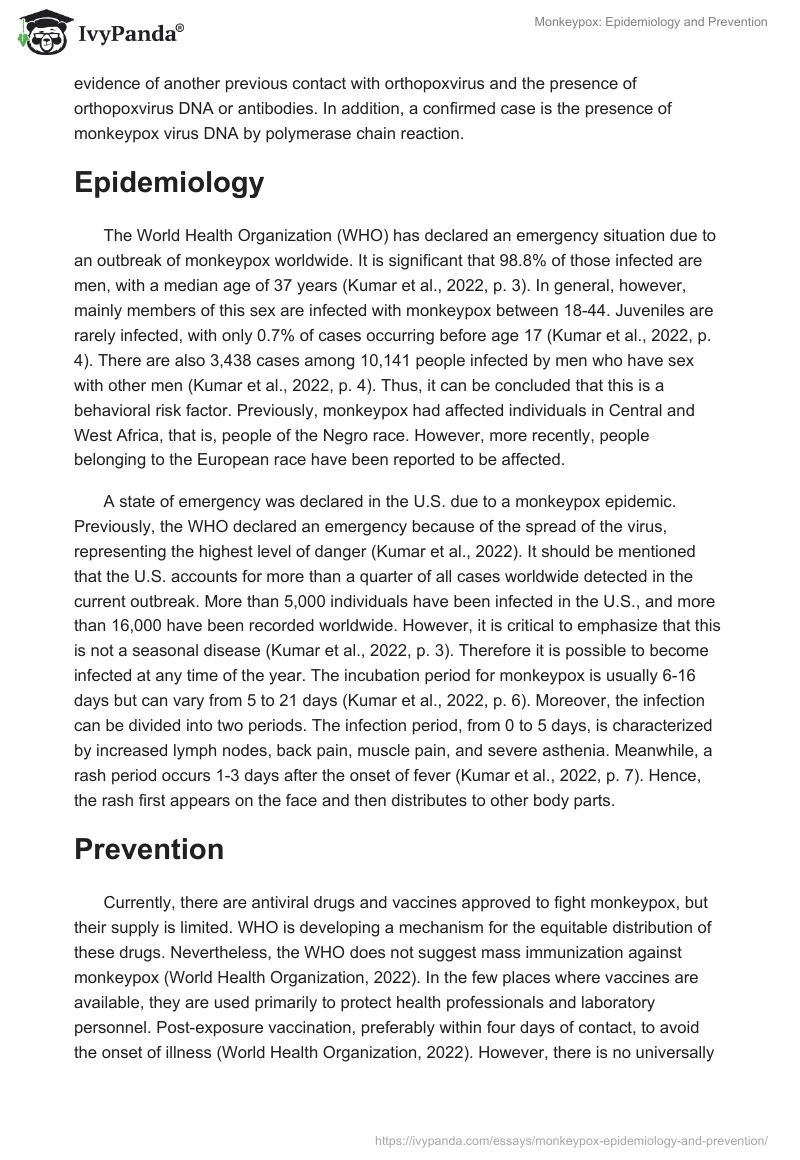Monkeypox
Monkeypox is a zoonotic disease that is transmitted from animals to humans. The pathogen belongs to the orthopoxvirus class and is related to smallpox but has milder manifestations and less lethality. West and Central Africa are considered the areas of distribution, but there are also episodes in other parts of the world (Guarner et al., 2022). It is essential to emphasize that the natural history of the monkeypox virus is still unknown to scientists, nor has the exact vector been identified, which makes research into the problem difficult. Monkeypox is a zoonotic virus, meaning that the virus is transmitted from animals to humans (Guarner et al., 2022). A significant number of infections occur not after biting or prying domestic rodents but by touching their bedding or through direct contact with an animal. Experts also do not exclude the alimentary route of infection when the virus enters the human body due to insufficient heat treatment of animal carriers.
The main channels of monkeypox infection are contact, that is, direct touch with a vector, and airborne, indirect contact through droplets trapped in the air after sneezing or coughing. There are extremely rare cases of a person being infected by another person (Guarner et al., 2022). However, it is quite challenging to catch the disease this way; it is imperative to be exposed to very close and prolonged exposure to the pathogen.
The National Notifiable Diseases Surveillance System monitors monkeypox outbreaks in the United States. Moreover, cases of the disease are also recorded by local and territorial health departments and transmitted to the Centers for Disease Control and Prevention (Centers for Disease Control and Prevention, n.d.). Accordingly, the data can be obtained from The National Notifiable Diseases Surveillance System (NNDSS). Therefore, the NNDSS establishes a set of uniform criteria used to classify and count disease cases. A suspected case includes newly characterized smallpox (Centers for Disease Control and Prevention, n.d.). A probable case means there is no evidence of another previous contact with orthopoxvirus and the presence of orthopoxvirus DNA or antibodies. In addition, a confirmed case is the presence of monkeypox virus DNA by polymerase chain reaction.
Epidemiology
The World Health Organization (WHO) has declared an emergency situation due to an outbreak of monkeypox worldwide. It is significant that 98.8% of those infected are men, with a median age of 37 years (Kumar et al., 2022, p. 3). In general, however, mainly members of this sex are infected with monkeypox between 18-44. Juveniles are rarely infected, with only 0.7% of cases occurring before age 17 (Kumar et al., 2022, p. 4). There are also 3,438 cases among 10,141 people infected by men who have sex with other men (Kumar et al., 2022, p. 4). Thus, it can be concluded that this is a behavioral risk factor. Previously, monkeypox had affected individuals in Central and West Africa, that is, people of the Negro race. However, more recently, people belonging to the European race have been reported to be affected.
A state of emergency was declared in the U.S. due to a monkeypox epidemic. Previously, the WHO declared an emergency because of the spread of the virus, representing the highest level of danger (Kumar et al., 2022). It should be mentioned that the U.S. accounts for more than a quarter of all cases worldwide detected in the current outbreak. More than 5,000 individuals have been infected in the U.S., and more than 16,000 have been recorded worldwide. However, it is critical to emphasize that this is not a seasonal disease (Kumar et al., 2022, p. 3). Therefore it is possible to become infected at any time of the year. The incubation period for monkeypox is usually 6-16 days but can vary from 5 to 21 days (Kumar et al., 2022, p. 6). Moreover, the infection can be divided into two periods. The infection period, from 0 to 5 days, is characterized by increased lymph nodes, back pain, muscle pain, and severe asthenia. Meanwhile, a rash period occurs 1-3 days after the onset of fever (Kumar et al., 2022, p. 7). Hence, the rash first appears on the face and then distributes to other body parts.
Prevention
Currently, there are antiviral drugs and vaccines approved to fight monkeypox, but their supply is limited. WHO is developing a mechanism for the equitable distribution of these drugs. Nevertheless, the WHO does not suggest mass immunization against monkeypox (World Health Organization, 2022). In the few places where vaccines are available, they are used primarily to protect health professionals and laboratory personnel. Post-exposure vaccination, preferably within four days of contact, to avoid the onset of illness (World Health Organization, 2022). However, there is no universally accepted vaccination schedule for people against the disease. For early detection of the disease, it is possible to be screened. For this, a healthcare provider uses a swab and takes samples from the affected area (World Health Organization, 2022). This provides the rest of the material to detect the monkeypox virus in the samples.
References
Centers for Disease Control and Prevention. (n.d.). NNDSS supports the Monkeypox response. Web.
Guarner, J., Del Rio, C., & Malani, P. N. (2022). Monkeypox in 2022—what clinicians need to know. Jama, 328(2), 139-140. Web.
Kumar, N., Acharya, A., Gendelman, H. E., & Byrareddy, S. N. (2022). The 2022 outbreak and the pathobiology of the monkeypox virus. Journal of Autoimmunity, 131, 1-7. Web.
World Health Organization. (2022). Monkeypox. Web.


